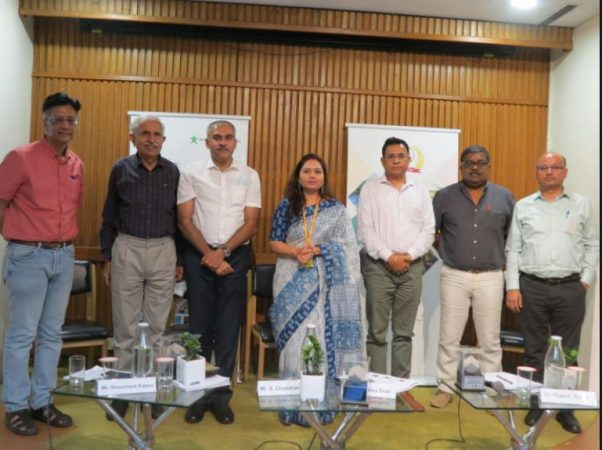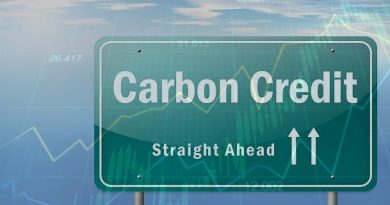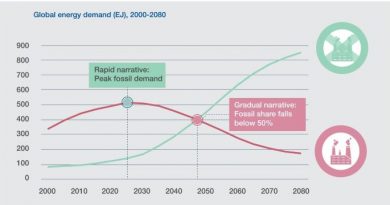Cement Sector Decarbonisation In Focus at trialogue 2047 By Development Alternatives

Recently , Development Alternatives Hosted trialogue 2047 to discuss the importance of Decarbonising the Cement industry. Trialogue 2047 is a series of discussions focused at building consensus on directions and measures India must take to accelerate a transition towards a truly sustainable future.
The 24th “trialogue 2047” brought stakeholders to discuss decarbonising the cement industry, which is considered one of the biggest contributors to environmental pollution. They included Ruchika Drall, Deputy Secretary, Ministry of Environment, Forest and Climate Change, GoI; S. Chandrasekar, IFS, Member Secretary, Bihar State Pollution Control Board; Dr. Jonathan Demenge, Head of Cooperation, Swiss agency of development and cooperation (India); Dr Soumen Maity, Vice President, Development Alternatives and Dr Mukesh Kumar, R&D Head, J.K. Laxmi Cement Ltd.

Mr. Dr. Soumen Maity, Vice President, Development Alternatives.
The discussion arrived at a consensus that the best way forward is to adopt transformative technologies that help in decarbonising the cement industry. This needs a strong commitment and cooperation on the part of the cement industry, government, institutions, civil society and academia. The focus was also on LC3, or Limestone Calcined Clay Cement as a viable alternative.
DA Group in association with École poly technique fédérale de Lausanne (EPFL) Switzerland, Indian Institute of Technology Madras and Delhi, and Universidad Central “Marta Abreu” de Las Villas, (UCLV) Cuba, supported by Swiss Agency for Development and Cooperation, India, Embassy of Switzerland have been working from the last decade on Limestone Calcined Clay Cement (LC3), which is seen as a major innovation to reduce emissions. LC3 reduces the clinker factor in cement production by the addition of calcined clay and waste limestone. While LC3 has become a cement of choice in over a dozen countries in Africa, South America, and South East Asia, the standards for commercially producing LC3 in India is at the final stages with the Bureau of Indian Standards (BIS). It is expected to be published very soon.
Decarbonising Cement Production
Cement production is one of the most resource- and energy-intensive process that cause a significant impact on the environment and natural resource base. Despite the progress by the Indian cement industry in enhancing energy efficiency, greenhouse gas (GHG) emissions from the cement sector are still significantly higher (187 million tonnes of CO2 in 2015-16) (GHG Platform India, 2016). The magnitude of projected demand for buildings and infrastructure in India will result in the cement industry expanding threefold by2050, resulting in a proportionate increase in the sector’s CO2 emissions. This is a cause for concern as the release of such large quantities of CO2 into the atmosphere will exacerbate the extent of global warming and intensify the effects related to climate change.
About Limestone Calcined Clay Cement
LC3 is a new type of composite cement based on a blend of clinker, calcined clay, and raw limestone. In LC3, clinker content can be as low as even 40%.The technology has several advantages over Ordinary Portland Cement (OPC) and Portland Pozzolanic Cement (PPC) such as:
- Reduces CO2emissionsby up to 40% as compared to OPC
- Lower energy consumption
- Comparable strength with OPC
- Improved durability
- Can be integrated within existing cement production
- Improved profitability
TARA, the “incubation engine” of the DA Group in association with IIT Delhi and IIT Madras has worked towards commercial production of LC3 in India. Lately, it has been a preferred technology and knowledge partner with large conglomerates in the sector such as JK Lakshmi Cement for the commercial production of LC3. It is hoped that with commercial use of LC3, India will be able to provide a profitable and viable solution against the adverse effects of climate change and achieve the nationally determined commitments made at COP26 by Prime Minister Narendra Modi
Speaking at the trialogue 2047, Ms. Drall said “Industry’s transition to low carbon pathway is important to meet the India’s goal to net zero by 2047. Leadership for industry transition (LeadIT) is one such initiative by the government of India to support transition of hard to abate sectors.”
S. Chandrasekar, said “In order to become a carbon-neutral state by 2040, Bihar is working on a long-term strategy for low carbon and climate-resilient development, partnering with organisations such as The Development Alternatives Group. Recently, we have completed a study on GHG inventory of the brick sector with the help of Shakti Sustainable Energy Foundation and Development Alternatives Group. To reduce emissions from the bricks sector, we promote fly ash technology in the state. There are over 500 fly ash brick enterprises in the state. We have also initiated GHG (Green House Gases) inventorisation of the cement plants in Bihar. LC3 will play a significant role in the state as well as in the country to minimise emissions.”
Dr Soumen Maity, added “We have been at the forefront in ensuring the decarbonisation of the cement industry. We have been working for over a decade to reach this juncture where a synergy between public and private partnership can be created. With the “trialogue 2047″ we hope the PPP approach will facilitate the final goal of decarbonisation.”
Dr Mukesh Kumar said “Our Company, JK Laxmi cement Ltd is involved in decarbonisation of cement production in various ways. JKL has signed an MOU on 3rd May 2022, in collaboration of TARA in presence of Shri Arun Kumar Shukla, President of JKL and Dr S.K Saxena.JKL has produced 5million tones of LC3 cement the year 2016 in collaboration of IIT Delhi and TARA.




